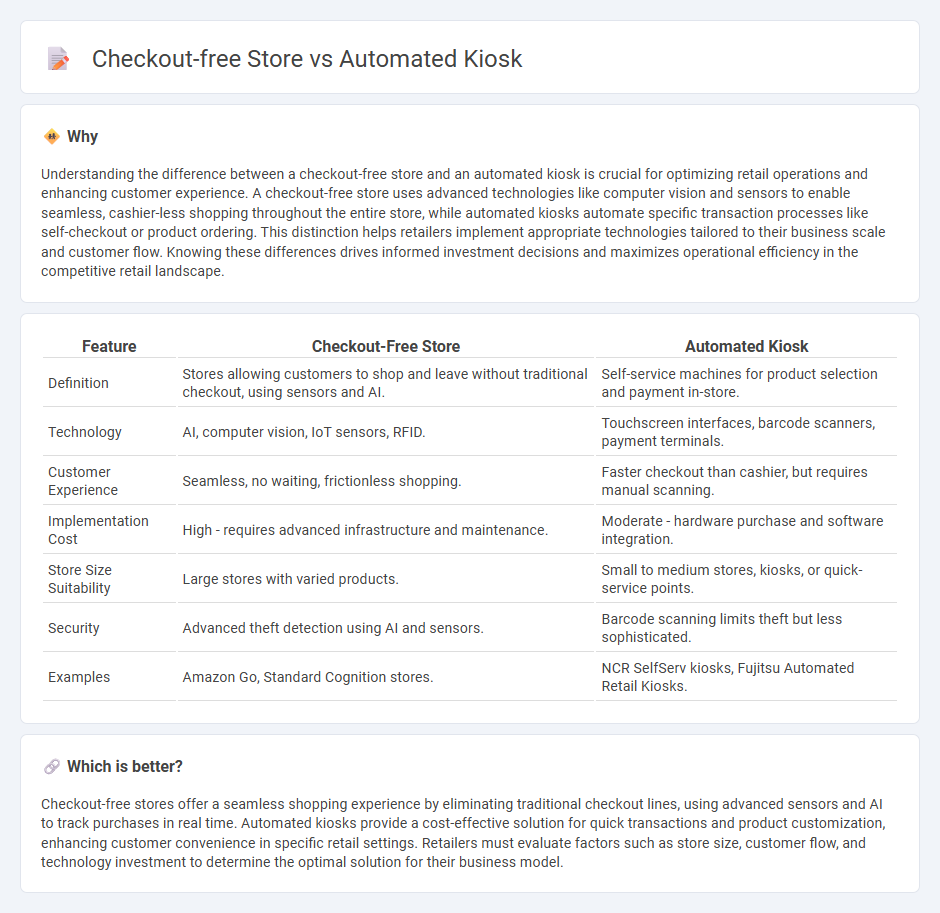
Checkout-free stores leverage advanced technologies such as computer vision and sensor fusion to offer a seamless shopping experience without traditional checkout lines, enhancing convenience and reducing wait times for customers. Automated kiosks provide self-service options through interactive touchscreens, enabling rapid transactions for specific items or services within retail environments. Explore the differences between these innovative solutions to understand how they are transforming the retail landscape.
Why it is important
Understanding the difference between a checkout-free store and an automated kiosk is crucial for optimizing retail operations and enhancing customer experience. A checkout-free store uses advanced technologies like computer vision and sensors to enable seamless, cashier-less shopping throughout the entire store, while automated kiosks automate specific transaction processes like self-checkout or product ordering. This distinction helps retailers implement appropriate technologies tailored to their business scale and customer flow. Knowing these differences drives informed investment decisions and maximizes operational efficiency in the competitive retail landscape.
Comparison Table
| Feature | Checkout-Free Store | Automated Kiosk |
|---|---|---|
| Definition | Stores allowing customers to shop and leave without traditional checkout, using sensors and AI. | Self-service machines for product selection and payment in-store. |
| Technology | AI, computer vision, IoT sensors, RFID. | Touchscreen interfaces, barcode scanners, payment terminals. |
| Customer Experience | Seamless, no waiting, frictionless shopping. | Faster checkout than cashier, but requires manual scanning. |
| Implementation Cost | High - requires advanced infrastructure and maintenance. | Moderate - hardware purchase and software integration. |
| Store Size Suitability | Large stores with varied products. | Small to medium stores, kiosks, or quick-service points. |
| Security | Advanced theft detection using AI and sensors. | Barcode scanning limits theft but less sophisticated. |
| Examples | Amazon Go, Standard Cognition stores. | NCR SelfServ kiosks, Fujitsu Automated Retail Kiosks. |
Which is better?
Checkout-free stores offer a seamless shopping experience by eliminating traditional checkout lines, using advanced sensors and AI to track purchases in real time. Automated kiosks provide a cost-effective solution for quick transactions and product customization, enhancing customer convenience in specific retail settings. Retailers must evaluate factors such as store size, customer flow, and technology investment to determine the optimal solution for their business model.
Connection
Checkout-free stores utilize automated kiosk technology to eliminate traditional cashier interactions, streamlining the purchasing process through sensors, cameras, and AI-powered systems. Automated kiosks serve as key components within these stores, enabling customers to scan and pay for items independently, which reduces wait times and enhances convenience. Integration of these technologies optimizes retail efficiency by minimizing labor costs and improving customer experience.
Key Terms
Self-service terminal
Self-service terminals in automated kiosks streamline retail transactions by allowing customers to independently scan and pay for items, reducing wait times and labor costs. Checkout-free stores use advanced sensor fusion, computer vision, and AI to enable customers to walk out with products without traditional checkout processes. Explore how self-service terminals transform the shopping experience and operational efficiency.
Computer vision
Automated kiosks leverage computer vision for item scanning and user authentication, enhancing speed and accuracy in self-service transactions. Checkout-free stores implement advanced computer vision systems combined with sensor fusion to track customer movements and automatically charge purchases without traditional checkout processes. Discover how computer vision transforms retail experiences by visiting our detailed analysis.
Sensor fusion
Automated kiosks typically rely on single-sensor technologies such as barcode scanners or RFID to process transactions, while checkout-free stores employ advanced sensor fusion techniques that integrate data from cameras, weight sensors, and RFID for seamless item detection and billing. Sensor fusion in checkout-free stores enhances accuracy in product identification and customer movement tracking, reducing errors and improving the shopping experience. Discover the latest innovations in sensor fusion that are transforming retail environments by exploring our detailed analysis.
Source and External Links
KIOSK: Self-Service Kiosks Manufacturer & Supplier - Offers custom self-service kiosks that automate operations in retail, financial, hospitality, and other sectors to improve efficiency and customer experience through solutions like payments, returns, check-in, and more.
Self-Service & Automated Kiosk Technology - LamasaTech - Provides automated kiosk solutions for restaurants, retail, ticketing, and reception with functions including self-ordering, payments, visitor sign-in, and smart ticketing to empower customers and reduce staffing needs.
Self Service Kiosks | Elo(r) Official Website - Supplies touchscreen and fully integrated self-service kiosks for enhanced customer interaction such as self-checkout, price checking, visitor check-in, smart pick-up cabinets, and access control, designed to improve loyalty and operational efficiency.
 dowidth.com
dowidth.com